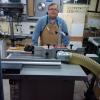Hi - Just purchased a woodhaven router coping sled. This one offers the option of either guiding off the miter slot or the fence (although I realized after that if you guide off the fence you risk routing into the sled base since it doesn't have a separate plastic guide as other sleds do.) However, that isn't the question I have.
The instructions say that if you choose to use the miter slot, it's critical that the fence be parallel to the miter slot. This doesn't make sense to me - but perhaps I'm misunderstanding something.
My assumptions:
1) You extend the workpiece past the end of the sled, with a sacrificial backer board to prevent blow out. The amount of extension should be such that the end of the piece is even with the shank of the bit.
2) Once you set that extension, the sled is guided by the miter slot to keep the distance constant as you move across the bit.
Three things in the instructions don't make sense to me.
1) If the fence is only used to set that depth, why is it critical that it's parallel to the miter slot? Obviously if it was completely skewed you'd have a hard time getting the depth right, but once you get that depth, the fence should be completely unnecessary.
2) They recommend using an auxiliary block between the fence and the end of the work piece to set that depth. The logic seems to be that you use this to butt the piece up against, but then as it moves to the bit, it clears this block and prevents jamming against the fence. This makes sense - but once you have the depth set and the piece clamped, why would you need anything there ? In other words, it seems to me that if the miter slot is the guide, you just need to use the fence to get the end of the piece in the right location and then you ought to be able to move the fence or a stop block completely out of the way.
3) If I'm correct about all of this, using the miter slot should not be any more "fussy" than guiding off the fence. If anything, the opposite since it's fixed and you don't have to worry about aligning it at all.
What am I missing?
Thanks!




 Reply With Quote
Reply With Quote



